What is floppy action in basketball
Floppy action, also known as a floppy set, occurs when an offensive player is initially near the lane or underneath the rim, and afterwards, that same offensive player executes a cut towards the perimeter by way of a single screen on one side of the lane or a double screen on the other side to receive the basketball.
Why is floppy action potentially effective
Floppy action is potentially effective because it incorporates various fundamental basketball skills, which could then lead to scoring or playmaking opportunities.
Essentially, when floppy action occurs, one designated off-ball offensive player will try to get open by way of a basketball cut initially towards the lane and/or underneath the basket followed by another cut towards the perimeter areas of the court.
This could be beneficial for that same player as well as the offensive team in general because it is usually difficult for the defensive team to guard off-ball and on-ball actions at the same time with great efficiency.
Furthermore, during floppy action, at least one designated offensive player could utilize certain types of basketball screens, specifically a pin down screen and/or a double screen to create separation from the defender that is guarding that offensive player.
Additionally, the screening actions could be very favorable for the offensive team, especially if the designated player that utilizes those screens happens to be one of the team’s best mid-range or three-point shooters.
It should be noted as well that it is possible to implement screen the screener action within the primary floppy set.
That is to say, an offensive player that initially sets a screen on one side of the lane could then quickly use another screen on the opposite side of the lane and cut towards the opposite perimeter.
This additional screen the screener tactic could lead to yet another potential scoring or playmaking opportunity, especially if the offensive player that utilized the first screen is not open to receive the ball.
Floppy action also includes the fundamental skills of passing, shooting, and possibly dribbling, in certain instances.
Basically, when a designated off-ball offensive player executes a basketball cut and utilizes a basketball screen to get open, another offensive player in current possession of the ball, usually near the top, could then throw it to that same off-ball player via a basketball pass such as the chest pass.
Following that, the offensive player that received the ball could then shoot it if open or possibly execute dribble penetration, particularly towards the basket, for alternative scoring or playmaking opportunities.
Moreover, floppy action could be useful as a counter when a defender attempts to jam the cutter that would use a down screen.
To provide clarity, let’s say team A scouts team B prior to a game and discovers that team B prefers to utilize the down screen, particularly to get their best offensive shooters open for jump shots.
From there, during the game, one of the defenders of team A attempts to mitigate or eliminate the effectiveness of that down screen by jamming the screen cutter, which is an offensive player of team B.
In other words, one of the defenders of team A could stand in the space between the inside shoulder of their assignment, (i.e. an offensive player of team B) and the outside shoulder of the screener, especially before the screening action happens.
When that occurs, the screen cutter and the screener cannot get shoulder to shoulder, which also means that the defender does not have to worry about fighting over the top of the screen or going under it.
By jamming the screen cutter in this fashion, the defender essentially makes the cutter take a long distance around the screen, which causes it to become inadequate at best.
Floppy action is able to counter the defensive jam by giving the screen cutter (i.e. the offensive player that would normally only use a single down screen) another option to get open for a potential scoring or playmaking opportunity.
Simply put, if the defender attempts to jam the screen cutter by standing in the space between the inside shoulder of the screen cutter and the outside shoulder of the screener, then the screen cutter could move in the opposite direction and use the other single screen or double screen.
As a brief example, if the defender is standing on the side of the screen cutter’s left shoulder, then the screen cutter could basically counter by cutting in the direction of their own right shoulder and then use the other single screen or double screen.
Related : Floppy – The Basketball Action Dictionary
What is an example of basic floppy action
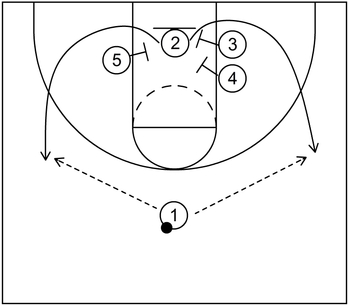
This is an example of very basic floppy action. Essentially, 2 begins underneath the basket with the option to utilize the single screen set by 5 or the double screens set by 3 and 4.
From there, 2 could cut towards the left side or right side wing. Afterwards, 2 could receive the ball from 1 and take the open three-point jump shot or possibly execute another type of playmaking action.
Affiliate Disclosure : I may earn a commission on qualifying purchases made through the links below.
What are examples of basketball plays that incorporate floppy action
Example 1 – Part 1
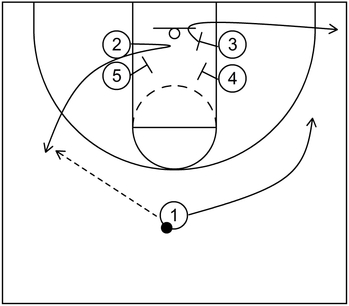
This is an example of a simple basketball play that incorporates floppy action to create scoring opportunities near the basket or near the perimeter.
To start this particular floppy set, the players swiftly line up in a stack formation near the lane.
Following that, 2 cuts underneath the basket to briefly set up the defender and afterwards, 2 cuts to the left side wing via the single pin down screen set by 5.
After that, 2 receives the ball from 1 and could take the three-point shot if that is open.
If 2 is not open, then 1 could cut to the right side wing while 3 flattens out to the right side corner.
Example 1 – Part 2
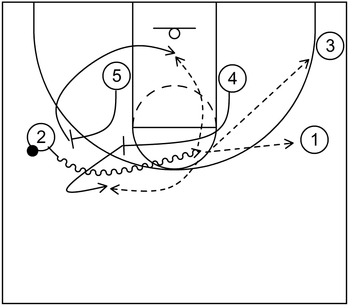
Next, 2 attempts to get dribble penetration towards the high post area via double ball screens set by 5 and 4.
After that screening action occurs, 5 rolls to the basket while 4 pops out to the left slot area.
From there, 2 could take the mid-range jump shot if open or 5 could receive the ball near the basket and score via a layup or dunk if that is viable.
Also, 1, 3, or 4 could receive the ball from 2 and potentially take three-point jump shots if those are available.
Example 2 – Part 1
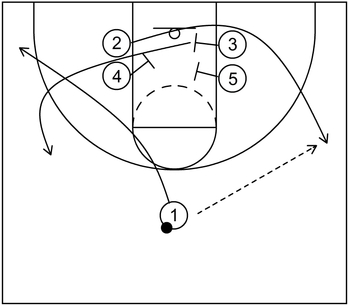
This is an example of a basketball play that incorporates floppy action from an initial stack alignment as well.
It is based on insights within Half Court Sets with Multiple Scoring Options by Dan Majerle.
To start, 2 cuts to the right side wing via the double screen set by 3 and 5. Following that, 3 cuts to the left side wing by way of the pin down screen set by 4, which also completes the screen the screener action.
From there, 2 receives the ball from 1 and could take the three-point jump shot if that is open. If 2 receives the ball but 2 is not open for the shot, then 1 cuts through to the left side corner.
It should also be mentioned that 2 could have cut to the left side wing via the single screen by setting up under the basket as well.
In that case, 3 would have simply popped out to the right side wing and then, 2 or 3 could have received the ball from 1 who would have then cut through to the weak side opposite the ball.
Example 2 – Part 2
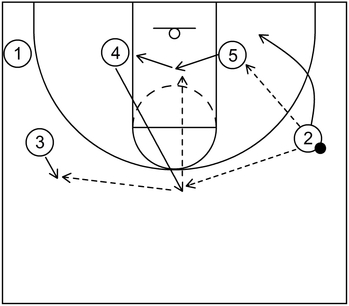
Next, 5 could receive the post entry pass from 2 and score near the basket via a low post move. If 5 is not able to receive the ball from 2, then 4 flashes high to the top and receives the ball from 2.
After that, 5 quickly ducks into the lane in an attempt to seal the defender under the basket while 2 cuts to the right side short corner.
From there, 5 could receive the ball from 4 to complete the high low action and score near the rim via a low post move.
If 5 cannot receive the ball from 4, then 3 pops out to receive the ball from 4, which completes ball reversal action as well.
Furthermore, 5 continues to cut across the lane to fill the vacant left side low post block.
Also, as a side note, Coach Majerle referred to the pop out action by the wing player, which is 3 in this example, as creating a lead.
Coach stated that in his offensive system, it is important for the wing player to pop out and receive the ball, particularly with their outside hand because the defender guarding that wing player would usually attempt to execute denial defense and/or deflect the pass, which stagnates the overall offense.
Example 2 – Part 3
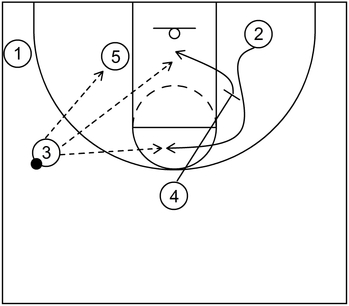
Continuing the action, 5 could receive the ball from 3 and attempt to score once again via a low post move. If that is not available, then 2 could cut to the high post area via the down screen set by 4.
At the same time, if the defender that is guarding 4 tries to disrupt 2 by cutting over or under the screen or the defenders of 2 and 4 execute a defensive switch, then 4 could slip the screen to the basket.
Following that, 2 could receive the ball and take the mid-range jump if that is open or 4 could receive the ball via the slip action and score near the basket with a layup or dunk.